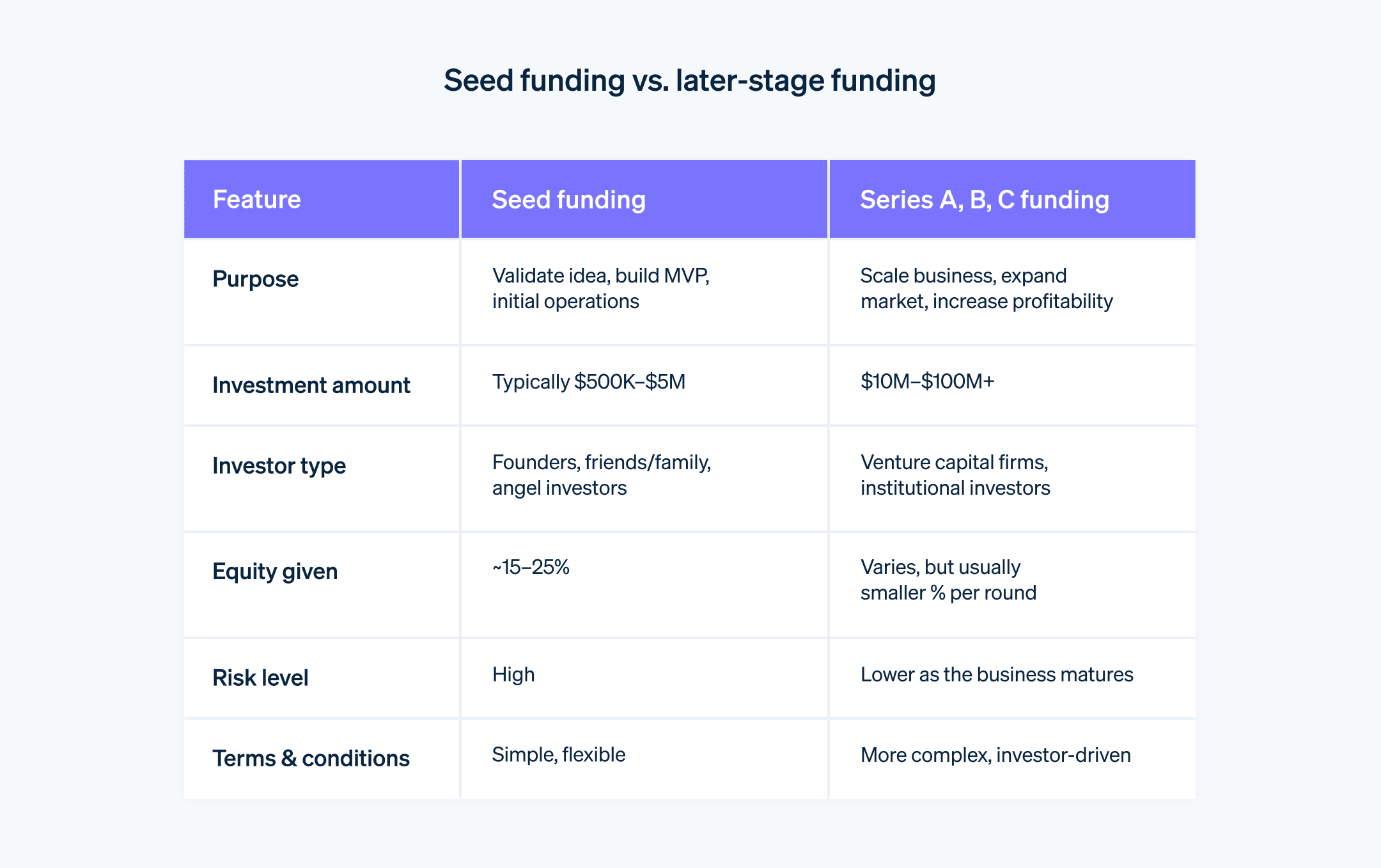种子资金(常被称为种子融资或种子资本)是创业者或创始人用于创办企业、启动新项目及覆盖初始运营成本的初始投资。与其他创业融资来源相比,这类资金通常金额相对较小。
种子资金有多种来源。其中包括创始人个人资金、亲友投资、天使投资人,以及早期风险资本公司。根据企业的性质和初期需求,所需的种子资金数额会有很大差异。种子资金能帮助创业者将想法从概念阶段推进到实体业务或产品落地阶段,进而向外界证明业务的可行性与潜力,以吸引更多投资。
在种子期之后,初创公司可能会寻求额外的融资轮次,如 A 轮、B 轮和 C 轮,这些融资通常涉及更大额的资本,可能来自风险资本公司、私募股权投资或其他投资者。
下文将介绍早期创始人在筹集种子资金时需了解的关键信息:资金获取渠道、如何根据特定业务目标选择合适融资来源、如何达成融资交易,以及如何合理使用种子资金。
本文内容
- 种子融资与其他融资类型的区别
- 种子融资为何对初创公司很重要
- 筹集种子资金的准备工作
- 种子资金的来源
- 如何为初创公司筹集种子资金
- 如何与投资者协商种子融资条款
- 管理种子资金的最佳实践
种子融资与其他融资类型的区别
初创公司在生命周期中会经历不同阶段,尽管各初创公司的发展阶段(及对应融资轮次)存在差异,但每个阶段都有普遍特征。
种子阶段可说是初创公司最具不确定性也最令人兴奋的时期。以下是种子融资与后续其他融资类型的区别:
目的与用途
种子融资主要用于将想法转化为可行的商业概念,通常包括开展市场调研、开发产品及组建团队。相比之下,A 轮、B 轮、C 轮等后续融资更聚焦业务规模化、扩大市场覆盖、升级产品或开拓新市场。金额
通常,种子轮融资金额远低于后续轮次。2023 年第一季度,种子轮平均融资金额仅为 360 万美元,而 A 轮平均金额达 1870 万美元。种子资金通常足以验证概念或达成重要里程碑,随着初创公司成长并展现潜力,后续轮次可吸引更大规模投资。投资者类型
种子资金来源通常包括创始人个人、亲友及天使投资人,这些个人或群体愿意为极早期想法承担风险。而后续阶段会吸引风险资本公司等机构投资者,它们向运营更成熟、有业绩记录的企业投入更大规模资金。2021 年,全球风险资本在 38,644 笔交易中投资了 6710 亿美元,单笔交易规模远超种子轮平均水平。股权与估值
种子阶段初创公司估值通常尚未明确,因此投资者投入相对少量资金即可获得较大比例股权。后续阶段,随着企业估值提升,获得大额资金所需出让的股权比例会降低。尽管每笔交易不同,但通常创始人需在种子轮出让约 20% 的股权。风险与回报
种子融资通常被视为高风险,因为业务模式与市场适配性可能尚未充分验证,但早期投资者可能获得更高股权比例,潜在回报也更高。随着企业成熟并进入后续融资轮次,风险降低,股权层面的潜在回报也随之下降。条款与条件
与后续融资轮次相比,种子融资协议的条款通常更少。随着企业成长并吸引更专业的投资者,融资协议复杂度会提升,条款也更严格。

种子融资为何对初创公司很重要
尽管每一轮融资都很重要,但即便金额通常较小,种子融资对初创公司的影响可能比后续轮次更大。种子融资可通过以下方面影响初创公司的发展轨迹:
验证商业想法
种子资金为验证初创公司的概念提供必要资金,此阶段的核心是证明产品或服务存在市场需求——这对吸引后续投资者至关重要。若没有种子资金,许多想法将永远无法进一步发展。奠定基础
初始资金能帮助初创公司搭建核心运营体系、招聘关键团队成员,并启动初步产品开发。推动早期成长和发展
借助种子资金,初创公司可专注于早期成长、完善产品/服务并建立客户群。早期成长能体现业务的扩张性与长期成功潜力。吸引后续融资机会
成功的种子轮融资不仅带来资金,还能向后续投资者证明企业价值,通常会推动 A 轮等更大规模融资——因为这表明初创公司已脱离概念阶段,拥有可行且处于增长中的业务。获得合作伙伴和导师
种子轮投资者通常不仅提供资金,还能提供宝贵的建议、行业资源及导师指导,这些支持对应对创业初期的挑战至关重要。保障灵活性与自主权
与后续轮次相比,种子融资的附加条件通常更少。此阶段初创公司有更大空间进行尝试,必要时可调整战略,无需承受大规模投资者的高期望压力及复杂协议约束。建立信誉
种子融资常被视为“认可印章”,能提升企业在客户、合作伙伴及后续投资者心中的公信力,表明专业人士或机构认可该初创公司的潜力。
筹集种子资金的准备工作
初创公司在接触首位潜在种子投资者前,需完成大量准备工作。以下是融资流程初期需执行的事项:
完善商业想法
接触投资者前,需确保商业想法清晰、具有创新性且针对真实市场需求。这包括开展深入市场调研、明确目标受众,并构建独特价值主张。制定完善商业计划
结构清晰的商业计划应包含业务模式、市场分析、运营策略、财务预测及长期目标,既是企业发展路线图,也是向潜在投资者展示价值的有力工具。开发原型或最小可行产品 (MVP)
若适用,需开发产品原型或最小可行产品 (MVP)。这一实体成果能向投资者证明,想法已脱离概念阶段,拥有可运作且可在市场中测试的产品。建立一支强大的团队
投资者不仅投资想法,更投资“人”。需组建技能与经验多元化的团队,证明团队具备执行力,能大幅提升投资者对初创公司的信心。纳入财务规划
明确所需融资金额及使用计划,准备好解释财务模型与预测,展示实现盈利或增长的清晰路径。制作投资者推介材料
制作有吸引力的推介材料,简洁说明商业想法、市场机遇、团队及财务情况,内容需生动、清晰、精炼,以吸引潜在投资者关注。筛选潜在投资者
调研并筛选与企业适配的潜在投资者(如天使投资人、风险投资家、孵化器或加速器),了解其投资理念与投资组合,定制沟通策略。拓展人脉与建立关系
在创业生态中主动建立关系,参加行业活动、加入创业社群,并在相关平台活跃,以接触潜在投资者与导师。准备尽职调查
投资者投资前会开展深入尽职调查,需整理好所有法律、财务及业务文件,以备查阅。

种子资金的来源
早期资金的来源将影响初创公司生命的第一阶段,并有可能影响其未来。这主要是由于各种融资协议的条款存在显著差异,且创始人与投资者的合作关系模式也各不相同。
在积极从各类渠道筹集种子资金前,需审慎权衡选择,确保所选融资来源能最大化您重视的收益,同时将您最反感的劣势与风险降至最低程度。以下是潜在种子资金来源的概览:
天使投资人
什么是天使投资人: 天使投资人是为初创公司提供资金的富裕个人,通常以可转换债券或股权作为交换。他们多为创始人出身或退休企业高管。
适配场景: 适合需要指导与行业资源对接机会的早期初创公司。
优点
提供个性化的关注和导师指导
条款灵活,流程较简便
带来宝贵的行业资源对接机会
缺点
资金规模有限
商业洞察力可能不及专业投资者
可能在业务方向或战略上产生分歧
风险投资家 (VC)
定义: 风险投资家是管理汇集资金并投资于高增长初创公司的专业机构,以股权作为交换。
适配场景: 最适合具备高增长潜力、且有明确路径实现可观营收与盈利的初创公司。
优点
可获取大额资金
具备业务规模化扩张的专业能力
拥有强大的行业资源网络
缺点
审核流程严格、竞争激烈
会失去部分企业控制权与股权
面临实现高增长与高回报的压力
众筹
定义:众筹是通过网络向大量人群筹集小额资金的方式。
适配场景: 适合面向消费者的初创公司、创新产品,或拥有动人故事及社会价值定位的企业。
优点
触达广泛受众
可验证商业概念
多数情况下为非稀释性融资(不稀释股权)
缺点
耗时且结果不确定
需开展有吸引力的营销活动
可能面临知识产权泄露风险
自筹资金
定义: 自筹资金指创始人仅依靠个人资金及公司收入启动业务,初始投入极少。
适配场景: 最适合初始资金需求低、且创始人希望完全掌控企业的业务。
优点
完全掌控企业
不稀释股权
推动精益运营与资源高效利用
缺点
资源有限可能阻碍增长
个人承担财务风险
业务规模化速度可能较慢
补助金
定义: 补助金是由资助方(通常为政府部门、企业、基金会或信托机构)向收款人提供的无需偿还的资金或物资。
适配场景: 适合科研导向、社会公益、教育类或环保型初创公司,或处于补助项目扶持范围内的特定行业企业。
优点
非稀释性筹资
提升企业信誉度
可专项资助特定项目
缺点
竞争激烈,申请标准严格
通常范围与规模受限
申请流程耗时

如何为初创公司筹集种子资金
明确目标融资来源后,可按以下策略推进:
若向天使投资人融资
筛选适配的天使投资人
利用人脉、天使投资人名录及行业活动,调研并筛选与初创公司目标契合的投资人,寻找了解且认同您所在行业与愿景的天使投资人。制作有吸引力的推介材料
推介材料需围绕企业构建动人叙事,突出解决的痛点与愿景,并结合市场分析、财务预测及详细商业计划提供支撑。建立合作关系
将每一次互动视为建立长期关系的机会,开展真诚沟通、重视对方建议并接纳反馈。需明确,您寻找的是合作伙伴,而非单纯的资金提供者。准备深入沟通
准备好阐述长期愿景,以及投资者的专业能力与资源如何助力企业成长。公平协商条款
与天使投资人的谈判通常更灵活,需清晰表达自身需求,并准备好理解与兼顾投资者的期望与立场。充分利用合作关系
天使投资人注资后,需借助其经验与资源推动企业发展,及时同步进展并邀请其参与关键决策,将投资转化为协作过程。
若向风险投资家融资
筛选合适的风险投资家
调研并锁定有投资您所在行业及企业阶段经验的风险投资家,利用人脉、在线数据库及行业活动,寻找投资理念与企业目标需求契合的机构。制作详细推介演示文稿
推介演示文稿需内容全面且数据支撑充分,展示业务模式、市场规模、竞争格局、产品、团队及财务预测。风险投资家关注具备可扩展性与高增长潜力的企业,需有力突出这些特质。证明业务进展与市场适配性
风险投资家通常投资已有一定市场进展或验证的初创公司,需提供客户关注度、收入、增长数据或合作关系等证据,证明业务的市场适配性与增长潜力。理解并准备严格的尽职调查
准备好应对严格的尽职调查,投资者会深入分析财务状况、法律事务、业务模式、市场调研及团队背景,需整理好所有文件与信息以简化流程。协商条款与估值
准备好就估值与条款进行艰难谈判,需理解自身企业估值并准备好论证,熟悉风险投资家常见条款,考量其对企业的长期影响。建立关系并传递愿景
尽管风险投资家核心关注回报,但建立合作关系也很重要。需传递长期愿景,说明其资金、资源与专业能力如何助力目标实现。
若通过众筹筹集种子资金
选择合适的平台
选择与企业产品或服务适配的众筹平台。不同平台面向不同项目类型与受众,需根据目标市场及众筹类型(股权众筹、回报众筹或捐赠众筹)选择契合平台。打造有吸引力的众筹活动
众筹活动需讲述企业的动人故事,说明其价值与独特性,搭配生动视觉素材与清晰有说服力的文案。视频在传递信息及与潜在支持者建立情感连接方面效果显著。设定合理目标与回报机制
根据受众规模设定可实现的融资目标,确保目标金额能支撑项目推进。回报众筹需设计有吸引力且可行的回报方案,既能激励捐赠,又不会过度消耗资源。推广众筹活动
利用社交媒体、个人人脉及社群论坛宣传众筹活动,定期向支持者与受众更新进展,保持持续互动。与支持者互动
不要将支持者仅视为投资人,他们是早期拥护者及潜在未来客户。在活动全程保持互动,包括更新进展、回复评论及感谢支持。规划众筹活动后的工作
明确活动结束后的规划,包括兑现回报、继续与支持者沟通,以及借助活动成功扩大业务影响力与知名度。
若通过自筹资金筹集种子资金
合理管理财务
优先注重财务审慎与预算管理,减少开支并将利润再投资于业务。区分个人与企业财务,保持账目清晰,避免不必要的财务纠纷。聚焦现金流
现金流是自筹资金模式的核心,需构建能产生稳定收入的业务模式,并密切监控现金流管理,以维持并扩大业务运营。充分利用现有资源
最大化利用现有资源,包括个人技能、人脉及资产,寻找低成本或免费工具与服务支持业务运营。逐渐成长
自筹资金通常意味着增长较慢,需聚焦逐步、可持续的增长,而非快速扩张。这种审慎方式能在不过度消耗资源的情况下为企业奠定坚实基础。采取以客户为中心的策略
由于无外部资金影响初创公司的方向,可让业务紧密贴合客户需求与反馈。利用这一优势建立稳固客户关系,并根据市场需求定制产品/服务。规划规模化路径
制定清晰的业务规模化策略,随着利润增长,将资金再投资于收益最显著的领域,如产品开发、营销或核心人才招聘。
若申请补助金
调研相关补助金
筛选与企业行业、使命或技术适配的补助金,利用在线数据库、政府网站及行业出版物,寻找契合业务模式与目标的资助项目。了解补助金要求
仔细阅读每项补助金的申请资格、材料要求及截止日期。资助项目通常有严格的特定要求与目标,需确保初创公司及申请方案符合这些条件。撰写详细申请方案
申请材料中需包含全面且有说服力的方案,清晰阐述商业想法、影响力、资金使用计划及预期成果,语言简洁明确,并遵循资助方的特定指南。证明影响力与创新性
许多补助金聚焦资助推动创新、社会影响力或技术进步的项目,需突出企业如何满足这些标准,并提供潜在影响力与创新性的证据。纳入预算与财务规划
提供详细预算,说明补助金的分配方式,证明财务责任感,并清晰阐述资金将如何推动项目进展。准备后续跟进与报告
若申请成功,需准备好后续跟进,可能包括按资助条款要求提交进展报告、财务报表或里程碑达成证明。
如何与投资者协商种子融资条款
潜在投资者会为自身或其基金中的投资者争取权益。以下是谈判中成功为自身争取权益的方法:
理解投资者视角
投资者核心目标是获取投资回报,即便认可您的想法,最终仍会权衡风险与收益。理解这一点有助于您组织论证逻辑,并理解对方的反驳观点。明确自身价值
谈判前需明确初创公司估值,除数据外,还需清晰认知业务潜力、市场规模及已达成的成果,并准备用数据自信地捍卫估值。倾听投资者意见
良好的谈判基于有效沟通,需积极倾听投资者表述并审慎回应。谈判并非单方面推进自身诉求,而是寻找双方共同点,达成互利共赢的协议。做好放弃交易的准备
谈判中的重要优势之一是愿意放弃不合适的交易。这并非采取对抗态度,而是明确初创公司成功所需的底线——若投资者条款低估企业价值或与愿景不符,需敢于拒绝。在合理范围内保持灵活
明确诉求很重要,但过于强硬会导致交易破裂。需设定清晰底线,同时在底线内保持灵活,例如在股权、投资结构或其他条款上协商。重视长期合作关系
需记住,您可能与投资者建立长期合作关系。谈判时应秉持尊重与合作意愿,目标不仅是获得资金,更是建立能支持初创公司成长的合作关系。关注条款细节
密切关注交易条款,而非仅关注表面金额。需理解清算优先权、反稀释条款、董事会席位等条款,建议咨询法律专业人士,确保完全知晓条款影响。谈判后保持沟通
谈判成功后,与投资者保持开放沟通,在适当范围内让其了解业务进展并参与决策,有助于建立稳固的长期合作关系。
管理种子资金的最佳实践
获得种子融资后,您需要决定如何使用这笔资金。以下是一些最佳实践:
根据企业计划确定支出的优先顺序
首先回顾商业计划,按照计划中明确的方向,将资金优先分配到推动业务增长与发展的领域,例如产品开发、市场调研或核心人才招聘。遵循商业计划可确保资金用于实现特定的战略目标。避免不必要支出
在保证质量的前提下厉行节约,即审慎评估每一项支出,杜绝不必要开销。例如,选择功能实用、性价比高的办公空间,而非奢华场地。需注意,省下的每一分钱都可投入到直接推动增长的领域。合理投入人才招聘
团队是最宝贵的资产,应招聘具备专业技能、认同企业愿景且致力于创业成功的人才。但团队扩张需审慎,过早大规模招人会迅速耗尽资源。聚焦产品开发与市场适配
将种子资金的很大一部分用于完善产品或服务,包括投入开发、测试及反馈机制建设,确保产品/服务满足市场需求且具备竞争力。制定营销策略与获客方案时注重策略性
投入性价比高的定向营销策略,优先选择投资回报率最高的渠道,并密切跟踪营销活动效果。保持现金储备
将部分种子资金作为现金储备,以应对突发支出或业务困境。现金储备能提供灵活性与安全感,帮助企业在财务压力较小的情况下应对挑战。密切监控现金流
定期监控现金流,确保初创公司财务健康,并根据需要调整支出计划。将利润再投资于企业
若初创公司开始盈利,可考虑将大部分利润再投资于业务,这能为进一步增长提供动力,并减少对额外外部融资的依赖。咨询导师或财务顾问
积极向导师或财务顾问咨询,他们的经验与见解对做出合理财务决策具有重要价值。做好战略调整准备
保持灵活性,必要时做好战略调整准备。创业环境变化迅速,根据市场反馈或新机遇调整支出的能力,将影响企业的成功。
Stripe Atlas 如何提供助力
Stripe Atlas 可为贵公司搭建法律框架,助贵公司在全球任意地点仅需两个工作日即可完成融资、开设银行账户及接受付款。
已有超 7.5 万家企业通过 Stripe Atlas 完成注册,其中包括获 Y Combinator、a16z 及 General Catalyst 等顶级投资机构支持的初创公司。
申请加入 Atlas
使用 Stripe Atlas 申请注册公司仅需不到 10 分钟。贵方可自主选择公司架构,即时核验公司名称是否可用,并添加最多四位联合创始人。贵方还需确定股权分配方案,为未来投资者和员工预留股权池,任命公司高管,最后通过电子签名签署所有文件。所有联合创始人也将收到邮件邀请,通过电子签名签署其对应文件。
在获取雇主识别号 (EIN) 前开通收款与银行账户功能
公司注册完成后,Stripe Atlas 将为贵方申请雇主识别号 (EIN)。持有美国社保号、美国地址及手机号码的创始人可享受美国国税局 (IRS) 加急处理服务,其他情况将适用标准处理流程(耗时可能稍长)。此外,Stripe Atlas 支持在 EIN 获批前开通收款与银行账户功能,助您在等待税务编号期间即可开展交易。
无现金式创始人股票认购
创始人可使用知识产权(如版权或专利)替代现金认购初始股份,相关认购凭证将存储于贵方 Atlas 管理后台。使用该功能需满足知识产权估值不超过 100 美元的条件;若您持有的知识产权价值高于此限额,请在操作前咨询专业律师。
自动提交 83(b) 税务申报
创始人可通过提交 83(b) 税务申报降低个人所得税负。无论贵方是美国籍或非美国籍创始人,Stripe Atlas 均可代为完成申报流程——采用 USPS 认证邮件寄送并附带物流追踪服务。贵方可直接在 Stripe 管理后台获取已签收的 83(b) 申报表及官方寄送凭证。
全球顶尖水准的公司法律文件
Atlas 为贵方提供创办公司所需的全部法律文件。Atlas 的 C 类股份有限公司文件由全球顶尖风投律所美国科律律师事务所 Cooley 联合设计,旨在助贵方立即启动融资,并确保公司获得全方位法律保护,涵盖股权架构、权益分配及税务合规等核心领域。
Stripe 支付服务首年免费,更享价值 5 万美元的合作伙伴专属优惠与折扣
Atlas 与顶级合作伙伴深度联动,为创始人提供独家优惠与资源支持,涵盖 AWS、Carta、Perplexity 等行业领军企业的工程开发、税务合规、财务管理及运营必备工具折扣,更免费赠送首年特拉华州法定注册代理服务。作为 Atlas 用户,贵方还将解锁 Stripe 专属权益——最高 10 万美元交易额的全年免费支付处理服务。
了解更多关于 Atlas 如何助您极速开启创业之旅,即刻启航。
本文中的内容仅供一般信息和教育目的,不应被解释为法律或税务建议。Stripe 不保证或担保文章中信息的准确性、完整性、充分性或时效性。您应该寻求在您的司法管辖区获得执业许可的合格律师或会计师的建议,以就您的特定情况提供建议。